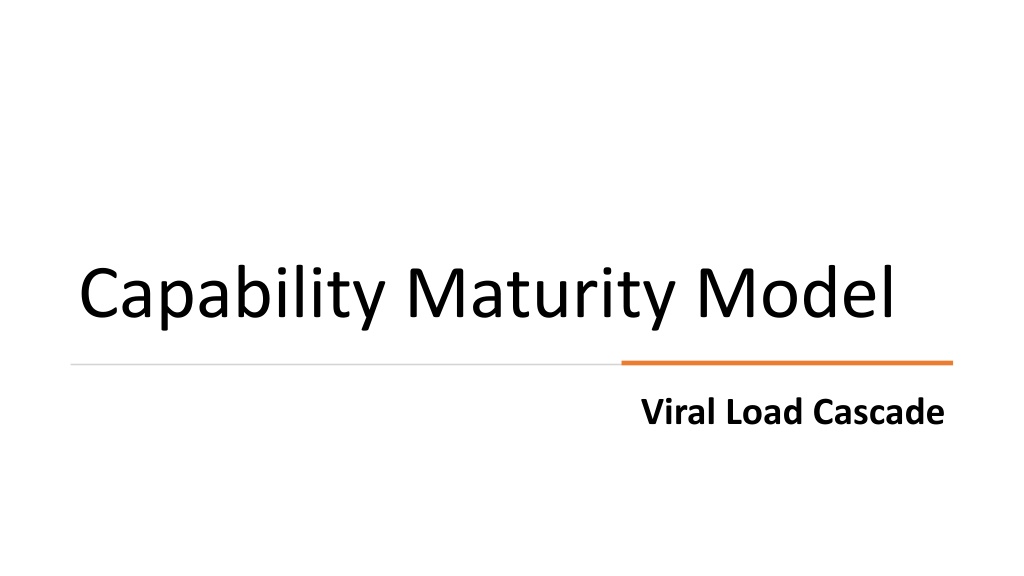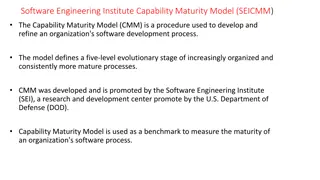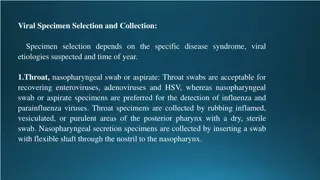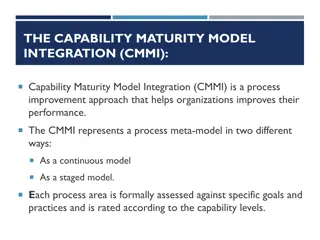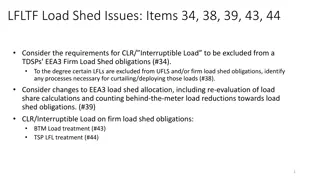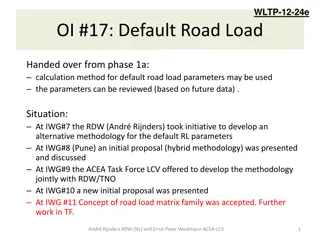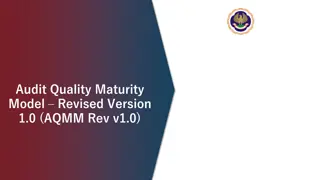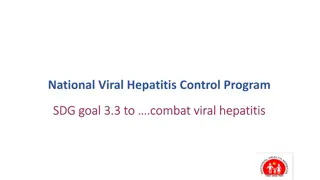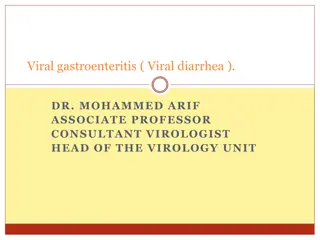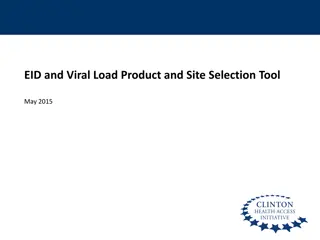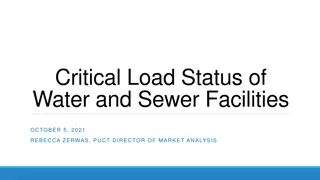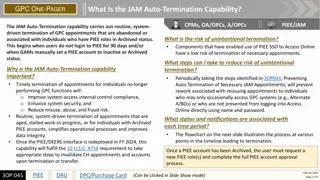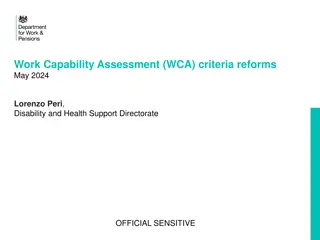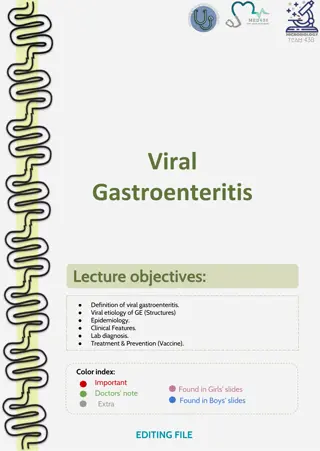Capability Maturity Model Cascade and Viral Load Testing Stages
This content discusses the Capability Maturity Model stages, focusing on process improvement and the stages of viral load testing demand creation. It outlines the evolution from initial to optimized stages and the development towards standardized processes in organizations. Additionally, it touches upon the awareness and education levels regarding viral load testing among clinicians, community leaders, clients, and the implementation of standard operating procedures. The Specimen Collection and Processing stages are also briefly mentioned.
- Capability Maturity Model
- Viral Load Testing
- Process Improvement
- Demand Creation
- Standardized Processes
Download Presentation

Please find below an Image/Link to download the presentation.
The content on the website is provided AS IS for your information and personal use only. It may not be sold, licensed, or shared on other websites without obtaining consent from the author. Download presentation by click this link. If you encounter any issues during the download, it is possible that the publisher has removed the file from their server.
E N D
Presentation Transcript
Capability Maturity Model Viral Load Cascade
CMM Stages Optimized Focus on process Stage 5 improvement Measured Processes are measured and controlled Stage 4 Stage 3 Defined Processes are defined and standardized for the organization Stage 2 Managed Processes are dependent on individuals and are not standardized Stage1 Initial - Processes are not repeatable, poorly controlled, and reactive
Demand Creation for Testing Stage 2 Stage 3 Increased awareness of VL testing in clinicians, however minimal information is shared with clients Clinicians occasionally order viral load testing for clients Community leaders/CSOs have an increased awareness of viral load testing and its role in ART monitoring Clients have an increased awareness of viral load testing and its role in ART monitoring Standard operating procedures for viral load testing and education are in development Stage 1 Stage 4 Stage 5 Clinicians unaware of access to viral load testing and have not been educated on its role in ART monitoring Community leaders/CSOs unaware of access to viral load testing and have not been educated on its role in ART monitoring Clients unaware of access to viral load testing and have not been educated on its role in ART monitoring No standard operating procedures for viral load testing and education Clinicians routinely educate clients about viral load testing and its benefits Clinicians routinely order viral load testing in- line with national guidelines Community leaders/CSOs play an active role in educating their community about knowing their viral load status Clients are aware of and actively seek viral load testing Viral load testing and education standard operating procedures are established and implemented across the organization Organization reviews routinely collected program data to measure performance in relation to standard operating procedures and national guidelines for clinician use of viral load testing and education of clients All stakeholders (e.g., clinicians, client groups, community leaders, etc.) play active role in community education about VL testing and promote campaigns for all individuals to know their VL Organization uses rigorous evaluation procedures and findings to demonstrate effectiveness and improve the process of demand creation for viral load testing
Specimen Collection and Processing Stage 1 Stage 2 Stage 3 Stage 4 Stage 5 No client access to viral load testing/specimen collection No standard supply chain system for specimen collection commodities (e.g., DBS bundles) so supplies limit ability to collect specimens Clinicians/personnel not trained to complete specimen requisition forms No standard operating procedures for appropriate viral load specimen collection and preparation Viral load specimens are collected occasionally and only on certain days, limiting client access to testing and increasing burden for clients to return for VL sample collection Increased capacity for supply chain system for specimen collection commodities, however not standardized Viral load specimens are collected routinely with few barriers for clients Standardized supply chain system for specimen collection commodities Clinicians/personnel complete specimen requisition forms accurately and completely Viral load specimen collection and preparation standard operating procedures are established and implemented across the organization Organization reviews routinely collected program data to measure performance in relation to standard operating procedures and national guidelines for specimen and collection preparation All stakeholders (e.g., clinicians, personnel, clients, etc.) play active role in appropriate viral load specimen collection and preparation to facilitate clients to know their VL Organization uses rigorous evaluation procedures and findings to demonstrate effectiveness and improve the process of specimen collection and preparation Increased awareness in clinicians/personnel for properly completing requisition forms Standard operating procedures for appropriate viral load specimen collection and preparation are in development
Sample transportation Stage 1 Stage 2 Stage 3 Stage 4 Stage 5 Organization uses rigorous evaluation procedures and findings to demonstrate effectiveness and improve the process of sample pick up and drop off. ART facilities' lab personnel unaware of when samples will be picked up. PCR facilities' lab personnel unaware of when the sample will be dropped off. ART facilities' lab personnel informed in advance when courier will arrive to pick up samples. PCR facilities' lab personnel informed in advance when the sample will be dropped off. Sample transportation company inform ART and PCR facility personnel when they are ready to pick up samples. ART facilities' lab personnel follow a preset schedule designed by transportation personnel to pick up samples. PCR facilities' lab personnel follow a preset schedule of when the sample will be dropped off. Reviews are performed at ART and PCR lab facility to measure performance in relation to standard operating procedures and preset schedule. Reviews are performed at Sample transporation entity to measure performance in relation to standard operating procedures and preset schedule. Sample transportation entity/personnel unaware of when to pick up sample from facilities. Sample transportation entity/personnel do not have a standard operating procedure and preset schedule for sample pick up and drop off. Sample transportation company follow a preset schedule to pick up samples from facilities. Standard operating procedure and preset schedule for sample pick up and drop off are established and implemented at the sample transportation entity and ART/PCR lab facilities. Standard operating procedure and preset schedule for sample pick-up and drop-off are in development at the Sample transportation company and ART/PCR lab facilities.
Laboratory Testing Stage 1 Stage 2 Stage 3 Stage 4 Stage 5 Organization reviews routinely collected program data to measure performance in relation to standard operating procedures and national guidelines for viral load specimen testing Inadequate lab infrastructure for viral load testing (i.e. space/storage/ equipment/reagents/kits for viral load testing) Laboratory staff are not properly trained nor competent to test viral load specimens Laboratory has little or no capacity for viral load testing No standard operating procedures or competency standards for laboratory viral load testing Improved laboratory infrastructure, however, laboratory is only able to receive and test viral load specimens occasionally or must refer to another laboratory Laboratory staff are trained, however, competencies are minimal Laboratory is has minimal capacity and viral load testing is occasionally completed in a timely manner Standard operating procedures and competency standards for laboratory viral load testing are in development Laboratory is able to regularly receive and test viral load specimens in timely manner Laboratory has appropriately trained and competent staff Laboratory is working at capacity and viral load testing is completed in a timely manner Laboratory viral load testing standard operating procedures and competency standards are established and implemented across the organization Organization uses rigorous evaluation procedures and findings to demonstrate effectiveness and improve the process of laboratory viral load specimen testing
Results Reporting Stage 1 Stage 2 Stage 3 Stage 4 Stage 5 Results are not received in a timely manner at the clinic from the laboratory Results are not recorded in the client s chart in a timely manner No standard operating procedures for results reporting and documenting results in the client s chart Results are occasionally received in a timely manner by the clinic from the laboratory Results are occasionally recorded in the client s chart in a timely manner but often not returned to clients Standard operating procedures for results reporting and documenting results in the client s chart are in development Results are regularly received by the clinic in a timely manner from the laboratory Results are regularly recorded in the client s chart in a timely manner and returned to the client regularly Organization reviews routinely collected program data to measure performance in relation to standard operating procedures and national guidelines for results reporting Clinic ensures a facility-based person is accountable for timely recording of VL results in client charts and notification of clients with VL>1000 to return to clinic prior to scheduled appointment Organization uses rigorous evaluation procedures and findings to demonstrate effectiveness and improve the process for results reporting Results reporting and chart documentation standard operating procedures are established and implemented across the organization
Results Interpretation and Client Management Stage 1 Stage 2 Stage 3 Stage 4 Stage 5 Viral load results are difficult to read and interpret and requires laboratory assistance Clinicians are not properly trained to interpret viral load results Clinicians are uncomfortable integrating viral load results into ART care Clients do not understand their viral load results Clinicians have no backup person to call to discuss difficult cases or clients who require 2nd line treatment No standard operating procedures for result interpretation and client management Viral load results are consistently readable and interpretable by clinicians Clinicians are adequately trained in viral load result interpretation Clinicians regularly discuss VL results with clients Clients understand their viral load results and can repeat their understanding back to the clinician Standardized system in which all providers have a designated POC/referral system in place to consult for management of VL results and switch to 2nd line Result interpretation and client management standard operating procedures are established and implemented across the organization Organization reviews routinely collected program data to measure performance in relation to standard operating procedures and national guidelines for client management All stakeholders (e.g., clinicians, personnel, clients, etc.) play active role in client management and their viral load Clinic has ability to identify missed opportunities for ensuring VL results are integrated with client management Organization uses rigorous evaluation procedures and findings to demonstrate effectiveness and improve the process of client management Viral load results are occasionally readable and interpretable and requires minimal laboratory assistance Increased awareness of result interpretation by clinicians Few clinicians are comfortable integrating viral load results into ART care Clients have a limited understanding of their viral load results Intermittent availability of consultation for 2nd line treatment Standard operating procedures for result interpretation and client management are in development
